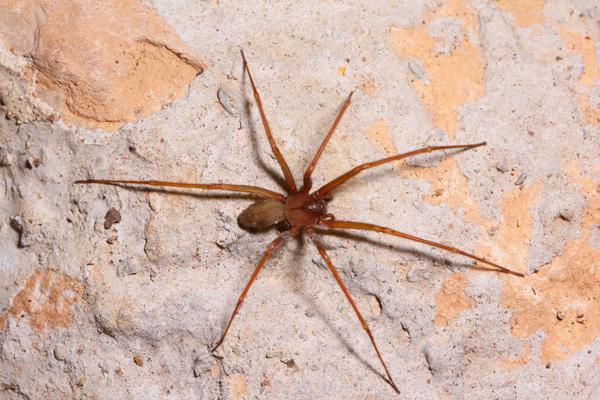“Medically significant” spiders are spiders with venom that can pose a serious or even life-threatening risk to humans. Of the 3,700 species of spider in the US, only about a dozen are considered medically significant. These dozen spider species fall into two groups: widow spiders (Latrodectus spp.) and brown spiders (Loxosceles spp.).
Black widow and brown recluse spiders are the most common (and infamous) of these spider groups, respectively. Both of these spider species inhabit the midwestern and eastern US. If you’re worried about spiders, these are the two species to watch out for. Here’s what they look like, what to do if you encounter them, and how to keep them out.

Black Widow
Yes, unfortunately, there are several species of black widow common in the US midwest. The most common is the
Northern black widow (
Lactrodectus variolus), which is established throughout eastern and midwest US. Black widows are around 1/2 inch long, with black bodies and a distinctive red, hourglass-shaped mark on their abdomens. Northern black widows may also have
orange, white, or red spots or bands along their bodies and legs. Males tend to be about half the size of females, and they’re lighter in color.
Black widows are rather infamous for their highly-venomous bite. They are considered to be the
most venomous spider in North America. Black widow spider bites affect the central nervous system. Though bites are virtually never fatal, they may trigger extreme pain, nausea, faintness, muscle spasms, sweating, and high blood pressure. Black widows are naturally shy and would always rather retreat than lash out, making bites rare. If you suspect you’ve been bitten by a black widow, seek medical attention as soon as possible.

Brown Recluse
The brown recluse spider (
Loxosceles reclusa) is a medically-significant venomous spider native to the southern and eastern US. The spider is also
slowly becoming more established in the northern US, though it’s still uncommon there. Brown recluses are between 1/4 and 1/2 inches long, with uniformly brown or tan bodies with no banding or striping. All adult brown recluses’ have a distinctive
dark, violin-shaped marking behind the top of their heads. They also have six eyes instead of the more common eight.
Brown recluse venom is hemotoxic, which means it affects blood cells and could potentially trigger local necrosis. Brown recluse bites are extremely uncommon, however, and even when they occur bites rarely result in serious problems. Unlike black widow bites, brown recluse bites are often not immediately painful. Symptoms including fever, chills, nausea, weakness, and joint pain
may develop in 24 to 36 hours. Brown recluse spiders are very shy and will not bite unless they’re threatened or cornered.
What to Do If You Encounter a Spider
Fortunately, there are very few circumstances where you’ll really have to worry about a spider you run into. That might not help you in the moment, of course, but it’s important to keep in mind. Both the black widow and brown recluse spiders
are not aggressive. The only time they’ll bite you is if they feel they have no other choice. Usually, spider bites occur when the victim inadvertently startles a spider they don’t realize is nearby or on their person.
If you see a spider either near you,
resist the urge to react immediately. Instead, remain still and observe what the spider is doing. If it doesn’t seem agitated, simply back away from it slowly and steadily. If the spider climbs onto you, attempt to give it something else to crawl onto naturally. If a spider bites you, clean, disinfect, and ice the area of the bite immediately. If you can, attempt to catch or preserve the spider so you can determine whether it was venomous. If you suspect it is, seek medical attention as soon as possible.
How to Prevent Spiders
Common spiders, including these venomous spiders, come into structures
to remain warm and catch prey. If you have spiders in your home, it’s because they’re feeding on other insect pests. In fact, spiders often build webs near highly-trafficked pest access points. If you find spider webs, search for cracks or crevices insects may use to access your home nearby. In general, spiders also prefer dark, secluded areas for building their webs.
The best way to prevent spiders is to
prevent them from accessing their food sources. To do that, you’ll have to control other pest populations in your home. Look for access points, especially around your basement and attic. Feel for drafts, reseal window and door frames, and seal cracks. Pay special attention to gaps around utility lines such as plumbing and electrical. Try to keep spider-vulnerable parts of your home as clean and clutter-free as possible. The fewer places you give spiders to hide, the less attractive a space will seem to them.
Venomous spider bites are very rare. Chances are, you don’t have black widows or brown recluses in your home. Even if you
do, chances are they won’t bite you. Even if they do bite you, chances are that bite won’t be dangerous. You shouldn’t necessarily be afraid of spiders, but you should be aware of them.
If you can’t help worrying about possible black widows or brown recluses in your home,
give Plunkett’s a call. We’ll identify your spiders, kick them out, and help you make sure they can’t come back.








